Hetu, A Blockchain for Collaboration

1. Rapidly Growing AI and Its Development Challenges
Artificial Intelligence(AI) is one of the fastest‑growing technologies in modern society. AI systems such as ChatGPT and Grok are seamlessly entering everyday life. ChatGPT alone has been used by an estimated 10 % of the global population, demonstrating that AI has evolved beyond a simple tool into autonomous AI agents and may ultimately culminate in AGI(Artificial General Intelligence) comparable to human cognition. Even OpenAI’s Sam Altman has predicted that AGI could emerge by 2025.
However, this meteoric rise brings serious centralization concerns. Today, AI R&D is dominated by a handful of large incumbents that monopolize vast compute resources and data sets. Although AI learns human‑like reasoning by ingesting massive Internet‑scale data, its training pipelines remain opaque, leading to uncontrolled data harvesting. Beyond privacy risks, this closed‑door model offers little or no compensation to data providers.
A case in point is the recent “Ghibli‑style AI image generator” trending on social media. While it reproduces Studio Ghibli’s distinctive animation style, Ghibli studios never consented to or were compensated for the use of their artwork. This example highlights how closed‑loop data collection and model training can infringe on creators’ rights.
Moreover, AI centralization stifles model diversity. When a few companies control model development, they tend to optimize AI for their own commercial interests, introducing systemic bias and reducing the ecosystem to a narrow set of profit‑driven models.
Therefore, if AI’s future is to evolve in an open, transparent manner rather than as a profit center for a few decentralization offers a promising solution. By building a DeAI network that ensures fair use of training data, accurately measures individual and institutional contributions, and allows anyone to participate in AI development and access, we can achieve equitable value distribution across all contributors.
2. Hetu, Proposing "Intersubjective Consensus" as a Solution
Current AI training processes require substantial resources and involve highly complex, asynchronous collaborations among numerous contributors. Furthermore, contributions from various actors, such as GPU cluster operators, data providers, and model fine-tuners, are inherently non-deterministic, non-quantitative, and subjective. This makes it impossible to accurately measure the contributions of each participant based solely on the final AI model outcomes.
This issue of contribution measurement is not confined solely to AI. Fairly quantifying contributions is also crucial across various collaborative ecosystems, including Decentralized Science(DeSci) and Decentralized Physical Infrastructure Networks(DePIN).
Many attempts have emerged to address these challenges through blockchain technology. However, traditional consensus algorithms such as Proof of Work(PoW) or Proof of Stake(PoS) handle only transactions with quantitative and objective results. Such outcome-centric blockchains struggle to capture complex collaborative processes involving subjective judgments and asynchronous interactions, making it difficult to fairly attribute and reflect contributions within the ecosystem.
Moreover, collaborative environments inherently involve numerous asynchronous events occurring simultaneously. Without the capability for efficient parallel processing, performance significantly degrades. Traditional blockchains arrange and process all transactions sequentially, leading to structural bottlenecks and delays in finality within these asynchronous collaborative settings.
To address these challenges, Hetu introduces a novel consensus mechanism called Proof of Causal Work(PoCW). PoCW solves performance issues by enabling parallel transaction processing and instant finality, while moving beyond simple objective consensus to capture the entire process and outcomes through "intersubjective consensus." Hetu’s primary goal is to fairly assess contributions recorded in complex collaborative processes and distribute value accordingly.
What is "Intersubjective Consensus," the Core Philosophy of Hetu?
Then, how do we differentiate between traditional “objective consensus” and Hetu’s core value, “intersubjective consensus”? Let’s explore this difference through Vitalik Buterin’s tweet and concrete examples:
A blockchain is a "truth machine" in the specific sense that it provides consensus approximate-truth over when messages were sent. It doesn't tell you "was the moon landing real?".This reduces the blockchain's attack surface by a lot, but it does mean we need other tools to actually do (or rather, assist with) the latter kind of truth-finding. — Vitalik Buterin
Vitalik highlights blockchain as a distributed trust mechanism that achieves consensus only on objective chronological orders, determining precisely when events occurred, not the complex nature of those events.
In other words, traditional blockchains represent digital events as objective facts. For instance, objective information like "Bitcoin’s price at 12 PM was $86.2K" can be easily verified. However, questions like "Was the first moon landing real?" or "Is meme coin culture positive for blockchain?" involve subjective judgments or require historical causal reasoning, which conventional consensus algorithms struggle to address. Therefore, Vitalik emphasizes that additional tools or mechanisms are necessary to reach consensus on such subjective truths.
While traditional blockchains rely on physical timestamps to achieve objective consensus, Hetu utilizes "logical clocks" to record the causal relationships between events, thus enabling consensus on subjective truths. Capturing causality involves tracking how earlier events influence later events, thereby comprehensively documenting processes involving subjective judgments, social opinion formation, scientific discoveries, and decentralized collaboration. Ultimately, these processes lead to achieving "intersubjective consensus." Consider this scenario:
A user reviews a research paper, claiming there's an experimental error. (Subjective opinion)
Another user counters this claim by re-analyzing data and providing evidence that the experiment is valid. (Subjective opinion)
Additional experimental results emerge, gradually leading to a broader consensus on the experiment's validity. (Intersubjective consensus)
This progression from opinion, counter-evidence, to broader consensus exemplifies causal relationships. Hetu assigns logical clocks to events from various perspectives and records these events on-chain, enabling comprehensive tracking and causal linkage. Continuous formation of new causal relationships among events allows network participants' opinions to converge naturally, ultimately reaching intersubjective consensus. This collective decision-making process is at the heart of Hetu’s philosophy and represents its core value: Intersubjective Consensus.
3. Proof of Causal Work(PoCW) for Intersubjective Consensus
3-1. Logical Clocks
Hetu aims to quantitatively track the causal relationship of outcomes reached through intersubjective consensus, fairly evaluating each participant’s contributions and distributing value accordingly.
Traditional blockchains order transactions based on physical timestamps, but Hetu utilizes a type of logical clock called vector clocks to assign logical timestamps to each event(transaction), allowing causal relationships to be accurately recorded and ordered.
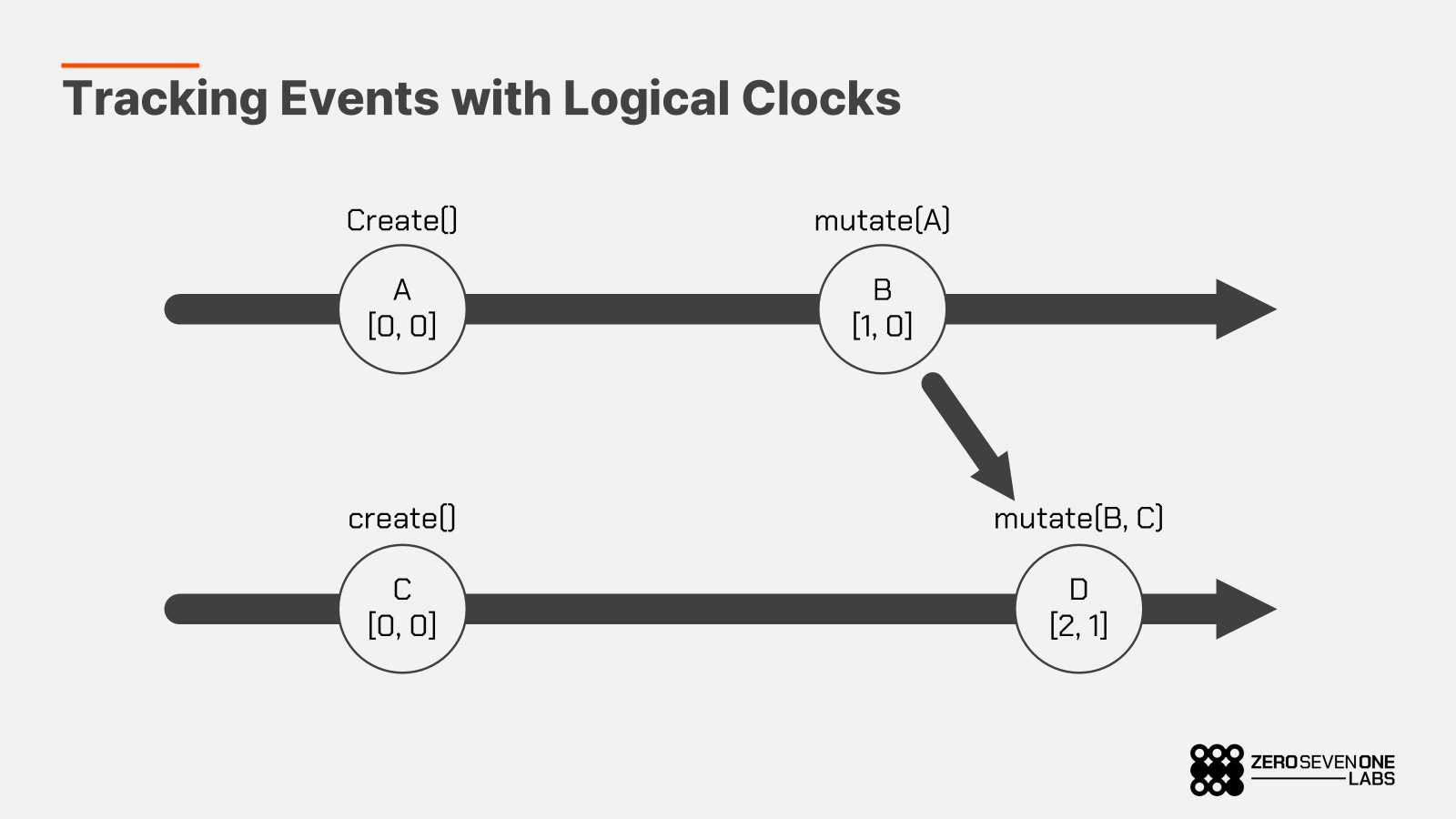
A [0, 0]: Created independently without relying on other events.
B [1, 0]: Causally dependent on A; increments the first clock element by 1.
C [0, 0]: Created independently without causal dependency on A.
D [2, 1]: Dependent on both B and C; increments the respective clock elements accordingly.
Vector clocks precisely record "who," "when," and "how many times" causal influences occurred, represented as an array of integers. For example, the clock [2, 1] indicates the event was causally influenced twice by the first event and once by the second event. This approach efficiently tracks causal relationships among events.
3-2. DOBC(Decaying Onion Bloom Clock) with Bloom Filters
Traditional vector clocks directly increment integer values at indices corresponding to each participant's ID. However, as events grow, the vector's length increases significantly, leading to higher storage and computational overhead.
To overcome this limitation, Hetu introduces a logical clock structure based on Bloom Filters (BF). A Bloom Filter is a fixed-size bit array structure. By hashing pairs of event state values and logical timestamps, it calculates indices within the array, incrementing the corresponding values by 1. This ensures the filter maintains a fixed overall size, enhancing both storage efficiency and computational performance, regardless of event count.
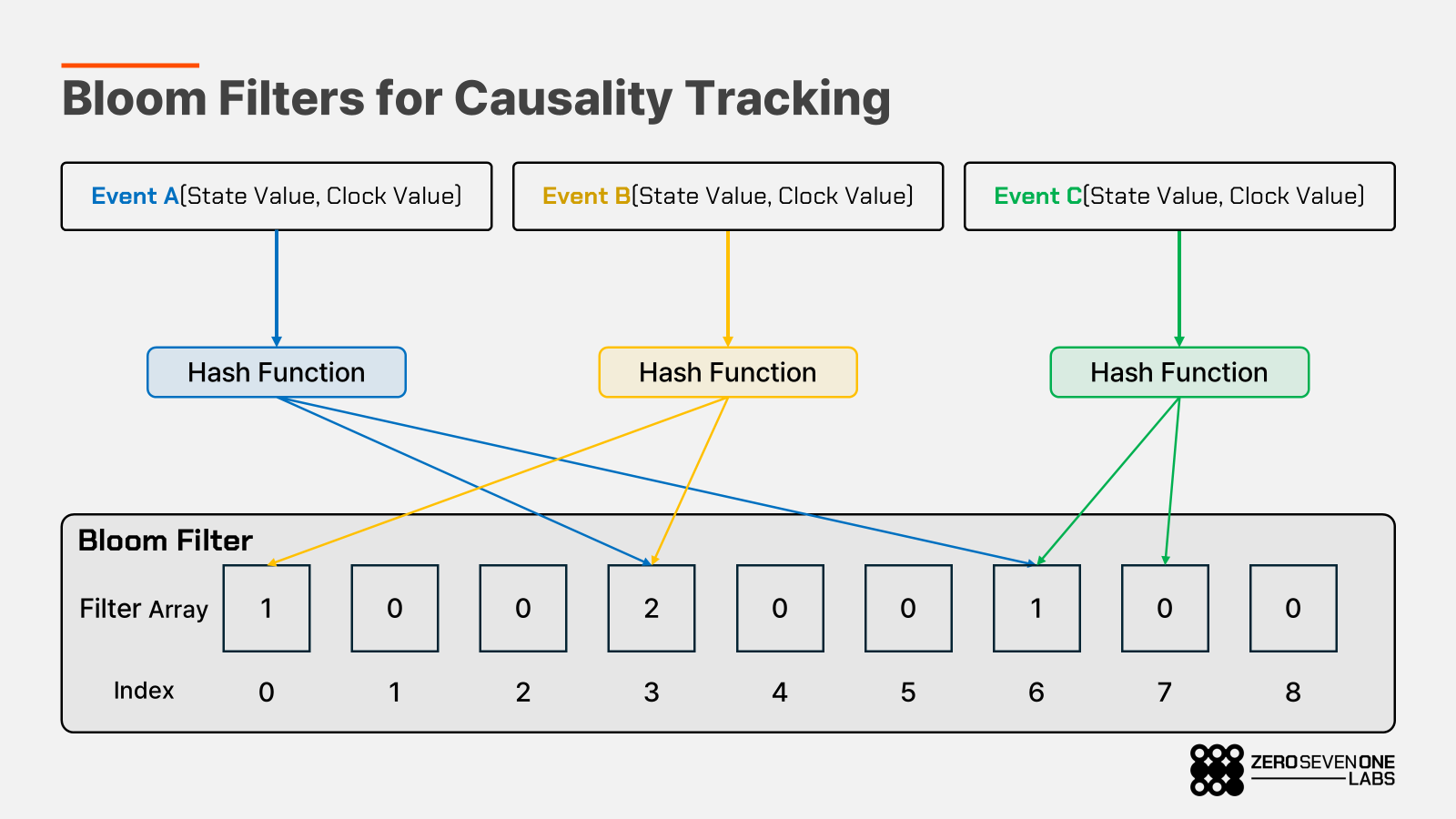
Each event's state value and logical timestamp pair are hashed into indices within the array, incrementing the values at those indices by 1. For instance, event C points to indices 6 and 7. Since index 7 was never incremented by prior events A and B(value remains 0), we can rapidly infer that event C has no causal dependency on events A and B.
However, using Bloom Filters in isolation presents certain limitations. While quickly identifying events without causal relations is straightforward, events with causal dependencies can only be probabilistically determined. Moreover, since the filter has a fixed size, the likelihood of hash collisions increases as the number of events grows. This gradually reduces the reliability of causal inference and makes long-term historical data retention increasingly difficult.
To address these limitations, Hetu designed and implemented the Decaying Onion Bloom Clock(DOBC) structure, which layers multiple Bloom Filters over time. When moving older Bloom Filters to subsequent layers, information is compressed by retaining only the maximum value at each array position.
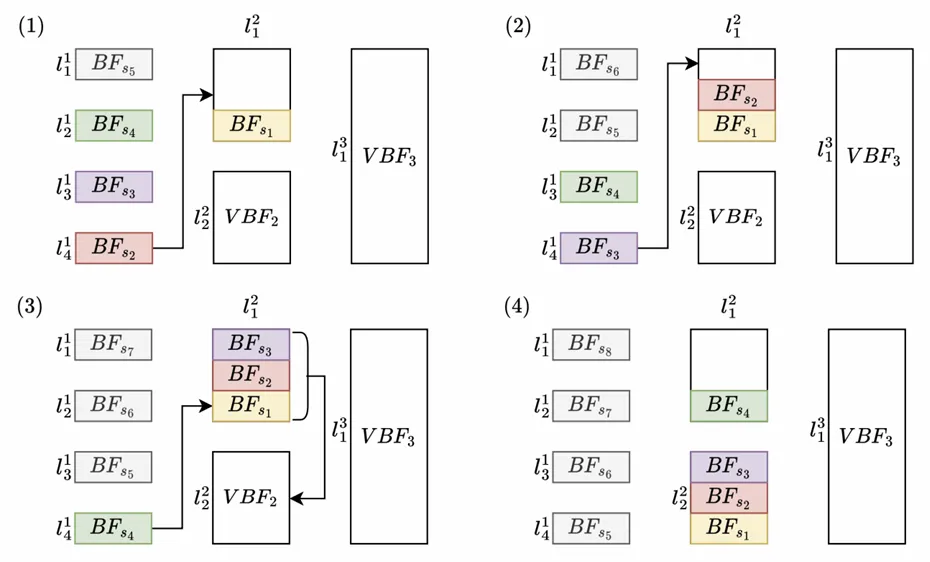
Step (1): A new event creates BF5, placed in Layer 1. The oldest BF1 moves to VBF1 in Layer 2.
Step (2): BF6 is created, BF2 merges into VBF1 in Layer 2 (compressing BF1+BF2).
Step (3): BF7 is created, BF3 merges into VBF1 in Layer 2 (compressing BF1+BF2+BF3). Since VBF1 is full, it moves to the next available position, VBF2.
Step (4): BF8 is created, and BF4 moves to the empty VBF1 in Layer 2.
Thus, DOBC naturally compresses Bloom Filters over time, maintaining higher precision for recent events, preserving the reliability of causal determination, and summarizing older events in a more compact form. Consequently, this method efficiently manages the logical clock size while preserving the accuracy needed for causal ordering.
3-3. Verifiable Logical Clock(VLC)
Accurately determining the contributions to outcomes requires tracking past causal relationships to verify the work done. However, since DOBC compresses Bloom Filters over time, accurately retrieving older causal information becomes difficult. To address this issue, Hetu introduces the Verifiable Logical Clock(VLC).
Each VLC includes both the logical clock and a cryptographic proof. Anyone can verify from this proof whether the clock was generated following specific protocol rules. Furthermore, this proof compactly encapsulates the entire history and sequence of events involved in generating the clock. This prevents deliberate omission or manipulation of intermediate steps. Additionally, using zero-knowledge proofs ensures computations remain private, allowing secure verification without exposing underlying data.
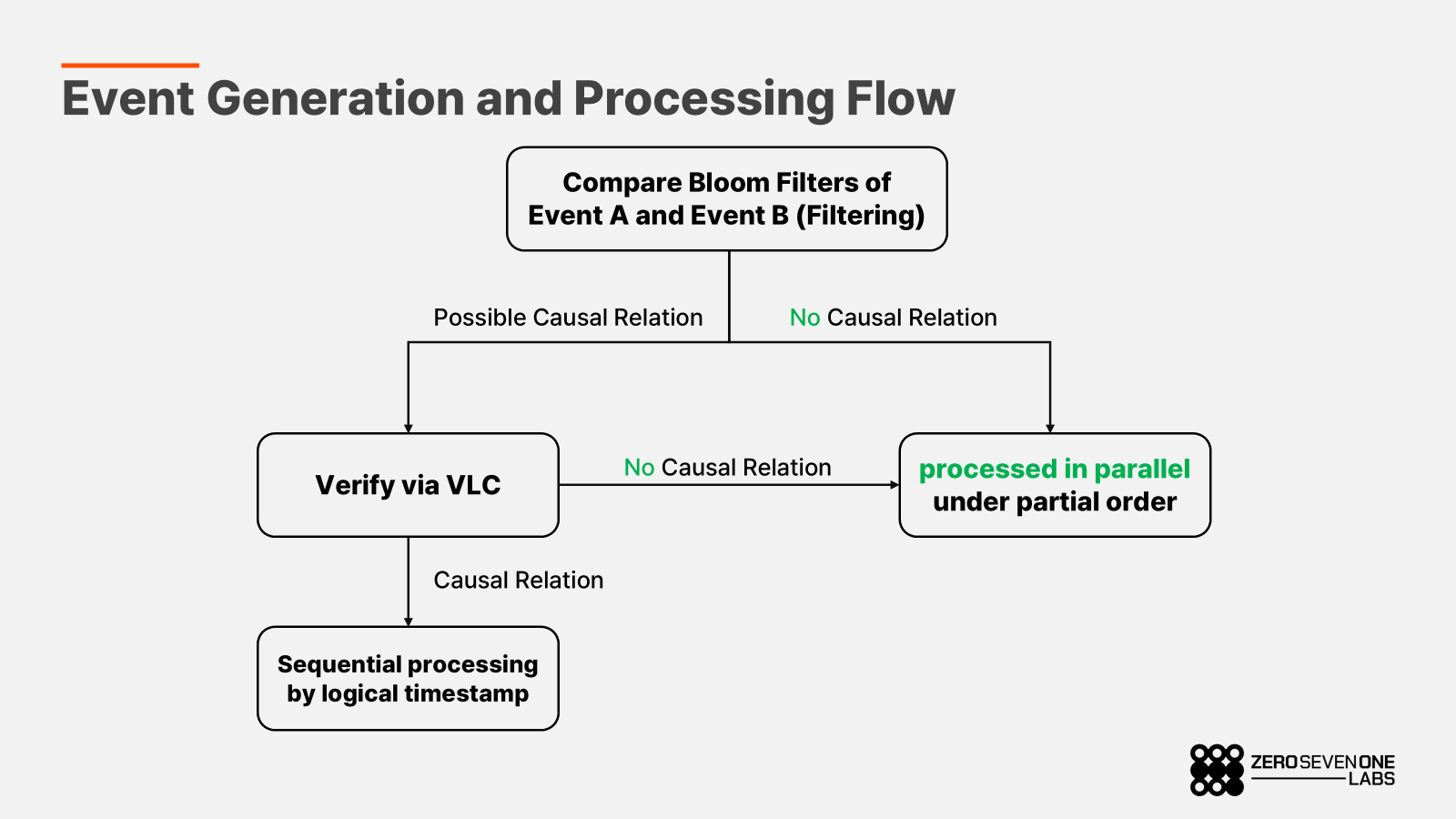
DOBC quickly filters out events without causal relations, enabling parallel processing based on partial ordering. Only when causal relationships are probable, VLC performs the necessary verifications, thus achieving accuracy, efficiency, and processing speed simultaneously. Unlike traditional blockchains, which serialize all transactions, resulting in unnecessary resource consumption and delayed finality, Hetu's approach simultaneously achieves efficiency, scalability, and instant finality.
4. A Unified Layer for AI and Science Ecosystems
The previously described Hetu’s Proof of Causal Work (PoCW) mechanism significantly diverges from existing blockchains, which primarily achieve consensus only on objective facts. PoCW facilitates the aggregation of diverse participants’ subjective viewpoints into a shared intersubjective consensus, tracing and fairly evaluating each participant’s contribution and subsequently distributing value accordingly. By adopting and refining this approach, Hetu aims to build a unified ecosystem suitable for decentralized scientific collaboration, characterized by complex asynchronous cooperation among numerous actors.
4-1. Modular Appchain Ecosystem Structure
Decentralized applications(dApps) in the domains of AI and science inherently require unique operational frameworks. Each app may employ distinct solutions and have specific requirements, such as AI model training methods, or protocols for conducting scientific research. Ignoring these differences and forcing diverse apps onto a singular monolithic blockchain structure diminishes operational efficiency and limits ecosystem scalability.
To accommodate this diversity, Hetu introduces a modular appchain architecture, allowing decentralized applications to construct their own specialized appchains based on their specific technical stacks, promoting easy onboarding into Hetu’s broader scientific ecosystem.

Within Hetu’s ecosystem, each appchain independently selects modules appropriate to its needs. For the Data Availability(DA) layer, appchains can choose from Hetu’s native solution(Hetu DA), external third-party DA providers, or even develop custom DA solutions. For the Execution layer, appchains may opt for standard execution environments such as EVM or WASM.
At the same time, all appchains are designed to rely on Hetu’s core consensus and settlement layers, utilizing PoCW for consensus on causal relationships and Hetu’s validators for transaction verification. By delegating consensus and validation responsibilities to Hetu, each application can build its own specialized appchain by selecting the modules it needs, while reducing the complexity and resource overhead of developing its own consensus mechanism and validator network. moreover, by leveraging Hetu’s security infrastructure, the barrier to deploying custom appchains is significantly lowered.
In addition, Hetu provides a foundation for token holders and validators to earn fees generated by appchain transactions, receive contribution-based rewards, and participate in ecosystem governance. This mutual structure forms a win-win relationship between Hetu and its appchains, promoting ecosystem expansion and operational cost efficiency.
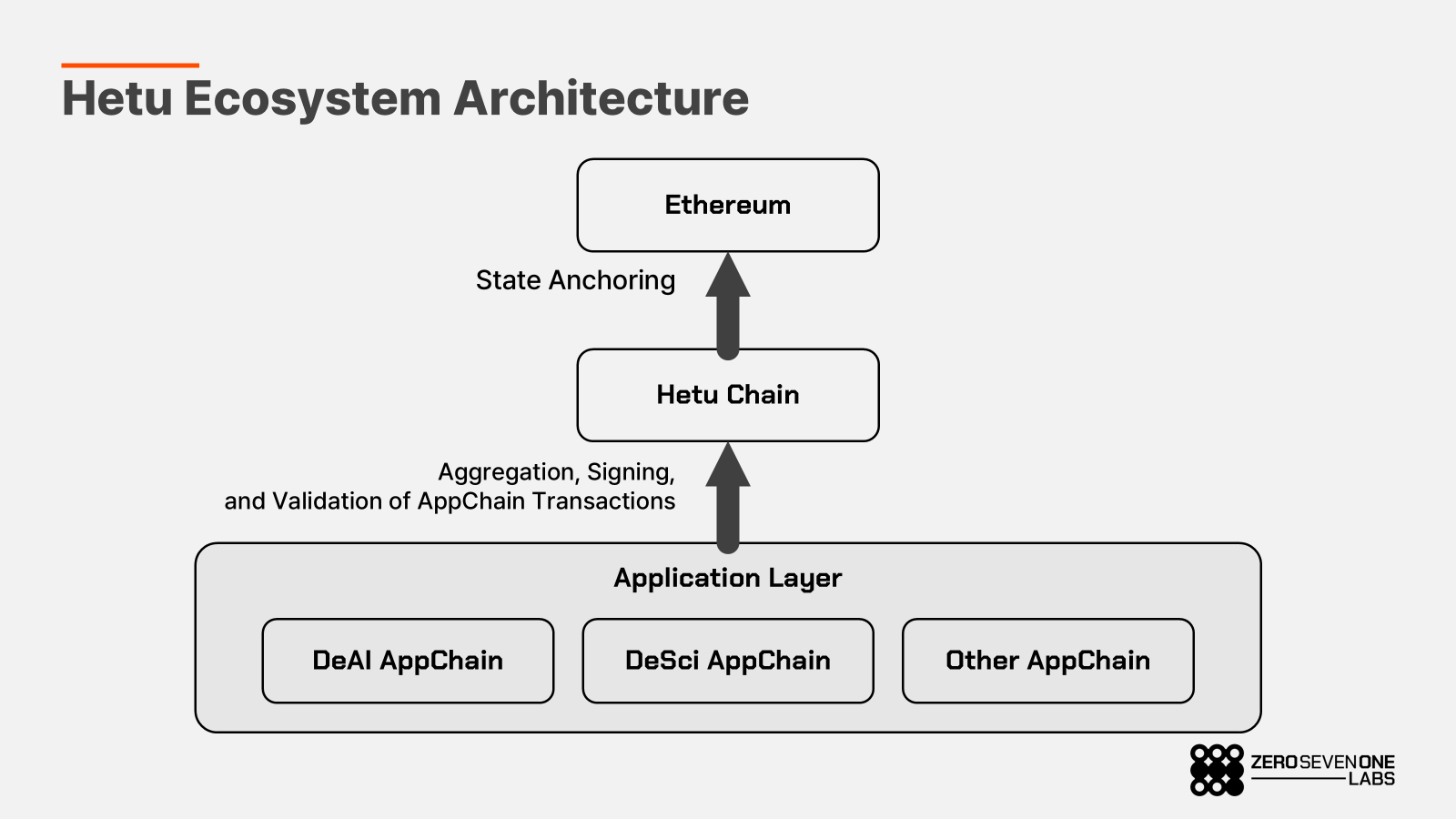
4-2. Diverse Experimental Projects within Hetu Ecosystem
Hetu is actively developing an ecosystem that enables diverse participants to collaborate according to their unique methodologies, with their contributions fairly evaluated and rewarded. To achieve this, Hetu employs PoCW to quantitatively measure and validate the causal relationships of contributions and incorporates modular appchain structures to enhance flexibility. Hetu is further experimenting with innovative projects that leverage its core components, notably the ModelGraph, to transparently track and visualize contributions throughout AI model development, composition, and usage.
1. ModelDAO – DAO for AI Model Contribution and Rewards
ModelDAO is a project designed to collaboratively develop open-source AI models, transparently tracking and rewarding contributions at every stage training, evaluation, and refinement using PoCW. It allows anyone to participate without centralized control, structuring the AI development process into clearly traceable steps, ensuring contributions are recorded in a fair and verifiable manner.
Through this approach, ModelDAO aims to explore the potential for decentralizing the entire AI research and development lifecycle, extending beyond simple community collaboration. ModelDAO is actively building a contribution-based scientific research ecosystem alongside partners such as AuraSci and VitaDAO.
2. AI4ScienceOS – Decentralized Operating System for Scientific Collaboration
AI4ScienceOS addresses the limitations of conventional closed and opaque scientific research processes by establishing a decentralized platform where anyone can freely share data, AI models, and collaboratively conduct research. Contributions are transparently tracked, evaluated, and compensated based on causality-driven frameworks integrated directly with Hetu’s technology stack.
Through this operating system, AI4ScienceOS aims to address critical issues including opaque contribution processes, fair value attribution, and transparent reward distribution, ultimately promoting a sustainable and collaborative decentralized science ecosystem.
3. ChaosChain – Experimental AI-Agent Governed Blockchain
ChaosChain is a governance blockchain entirely operated by AI agents without human intervention. AI agents take full responsibility for managing the blockchain and can participate in every step of governance from proposal submission to voting and execution with all actions transparently recorded on-chain.
This project experiments with Hetu’s philosophy of intersubjective consensus, using AI agents as the primary participants. It explores the full spectrum from the agents’ subjective judgments to the formation of intersubjective consensus. Ultimately, ChaosChain serves as a testbed for experimenting with future forms of collaboration between AI and humans on the blockchain.
5. Distinctiveness through Purpose and Philosophy
The diverse experimental approaches described above illustrate how Hetu goes beyond merely providing technical infrastructure, embedding a deeper philosophical foundation intersubjective consensus into the construction of decentralized ecosystems for science and AI. Rather than solely pursuing generic ecosystem expansion, Hetu proactively undertakes experimental initiatives to embody and actualize its core philosophical principles, reflecting a distinct commitment rarely observed in typical blockchain projects.
Of course, Hetu is currently at the testnet stage, with its mainnet scheduled for launch in the third quarter of 2025. Additionally, its tokenomics have not yet been publicly disclosed, leaving open questions regarding how token value alignment with ecosystem growth and incentive mechanisms for onboarding appchains will be specifically structured.
Nevertheless, Hetu remains highly anticipated due to the following distinguishing features:
1/ Clear Purpose and Coherent Philosophy
Hetu directly addresses the fundamental, yet unresolved challenge in decentralized collaboration:
“How can contributions be quantitatively measured and rewarded fairly?”
This critical question remains a core unresolved issue within Web3 and blockchain communities, extending beyond mere technological efficiency or transactional throughput. Hetu uniquely concentrates on the practical, real-world challenges of establishing trustworthy collaboration and equitable contribution tracking within decentralized scientific and AI-driven ecosystems.
At the heart of Hetu’s approach is the concept of intersubjective consensus, a philosophical framework that informs every component causality tracking, contribution evaluation, and incentive distribution. This philosophy is not merely stated theoretically in a whitepaper but is clearly and systematically implemented at the protocol layer itself, creating a consistently aligned and integrated architecture.
2/ Realistic Architecture and Meaningful Differentiation
In recent years, blockchain projects frequently launch as Layer 1 platforms, resulting in significant fragmentation of ecosystems. Additionally, many Layer 1 and Layer 2 platforms offer similar technologies with marginal improvements, such as higher TPS, thereby continually reproducing nearly identical ecosystems without distinct value propositions.
In stark contrast, Hetu adopts a pragmatic modular architecture, placing itself as a Layer 2 ecosystem with specialized appchains expanding independently underneath. This design prioritizes practical usability and genuine scalability. Hetu has uniquely aligned its objectives, philosophical grounding, and technical architecture into a cohesive whole, significantly differentiating itself from blockchain projects that merely present theoretical visions or incremental technological upgrades.
Ultimately, with its pragmatic architecture, Hetu is not just another blockchain it is a project that meaningfully demonstrates how decentralized collaboration in the fields of AI and science can be practically realized. This is precisely why it deserves attention. Once the mainnet is launched and the tokenomics are revealed, it will be even more exciting to see how this structure connects to real ecosystem growth and contributes to fulfilling Hetu’s vision.